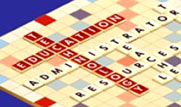Online learning is no longer a novelty item and though not yet mainstream, it is becoming an accepted tool in a teacher's bag of tricks. While we are still learning about the whole field of online learning, there is an emerging body of knowledge around areas such as instructional design and pedagogy for online learning. The area of project management has, perhaps, received less attention, but interest appears to be growing as organisations begin to recognise the risks and costs associated with developing quality online learning resources.
The development of effective resources typically involves the management of limited funds, tight time lines and a diverse range of people. The skills acquired managing other educational projects do not necessarily translate well to the field of online learning. Similarly, the skills that make someone a good classroom teacher or web designer do not match well against those required in an online learning project manager. Experience in the VET sector indicates that budget and timeline overruns can frequently be tracked backed to the same group of clearly identifiable causes. Many of these identified risks are avoidable and the others can generally be limited through reasonable foresight and prior planning. This presentation will explore these potential risk areas and outline strategies that project managers can apply to combat them.

